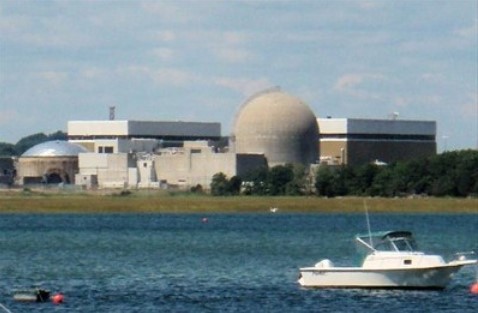By DAMIEN FISHER, InDepthNH.org
NextEra, owner of Seabrook Station, allowed its infrastructure to degrade to the point of risking a nuclear meltdown as part of a scheme to keep competitors at bay, according to a lawsuit brought by clean energy company Avangrid.
The federal lawsuit filed this month in the United States District Court of Massachusetts Western Division accuses NextEra of engaging in a scorched Earth campaign to derail Avangrid’s New England Clean Energy Connect project. Also known as NECEC, the project aims to bring lower cost hydroelectric power from Canada to Massachusetts, with a transmission line running through Maine and New Hampshire.
“To accomplish its scheme, NextEra has abused the regulatory and judicial process, misled voters with illegal dark money and false statements, and obstructed electric infrastructure improvements. As an incumbent electricity supplier with significant power generation assets in New England, NextEra has used these anticompetitive and tortious tactics to line its own pockets by excluding lower-priced competition for electricity supply in Massachusetts from Avangrid’s New England Clean Energy Connect project,” the lawsuit states.
The NECEC project was authorized by the Massachusetts legislature as part of its plan to transition off of fossil fuels. NextEra tried and failed to win the NECEC contract, losing to Avangrid in 2018.
NextEra then sought to delay the project through regulatory appeals called “absurd” by the regulatory bodies, fought an illegal referendum campaign in Maine that resulted in sanctions against NextEra shell companies, and finally through possibly the most alarming allegation in the lawsuit, NextEra’s reported strategy to allow New Hampshire’s Seabrook Station nuclear power plant to risk meltdown as a wedge to keep Avangrid’s NECEC stalled. It’s a strategy that NextEra reportedly admitted to in a prior lawsuit, according to Avangrid’s complaint.
“NextEra controls the Seabrook Breaker, which protects its Seabrook nuclear power plant from technical problems that could arise in the power grid. But against its own safety and engineering interests, NextEra allowed the breaker to age to the point that it had reached near-capacity, such that any additional source of power added to the grid could overwhelm the breaker and risk a catastrophic nuclear event,” the lawsuit states. “Accordingly, the regional grid operator, ISO-New England, could not allow any significant new power source project to connect to the grid unless and until NextEra upgraded the breaker. Thus, NextEra positioned its aging equipment as a bottleneck that it alone controlled, creating for itself—and then wielding—the power to veto any rival power source from connecting to the grid. NextEra admitted in open court that by purposely refusing to upgrade its safety equipment, it secured a ‘veto’ over NECEC and other electricity suppliers aiming to enter the markets.”
Contacted for comment, NextEra did not respond to the allegation that it purposefully risked a catastrophic nuclear meltdown to gain a competitive edge.
“We are reviewing Avangrid’s complaint, and we look forward to vigorously defending against these claims in court,” NextEra stated.
Sarah Abramson, Executive Director of local watchdog group C-10 Research & Education Foundation, Inc., said her group has gone to court itself over NextEra’s actions and is not surprised by Avangrid’s allegations.
“At C-10 we were frustrated, but not surprised, by NextEra’s campaign finance violations, and feel strongly that the public should be abhorred by this dubious behavior of our local nuclear power plant trying to illegally influence legislators,” she said. “We need our elected officials to prioritize their constituents’ safety, especially with the cracks in the plant’s concrete getting worse, with NextEra proposing cuts to their on-site emergency response resources, and with climate change bringing more frequent and severe flooding of coastal roads that would be unusable if there were a radiological emergency evacuation.”





